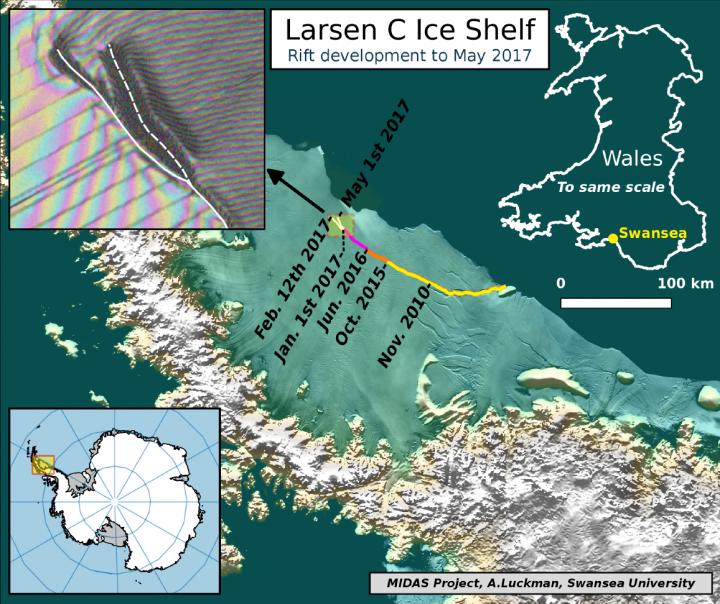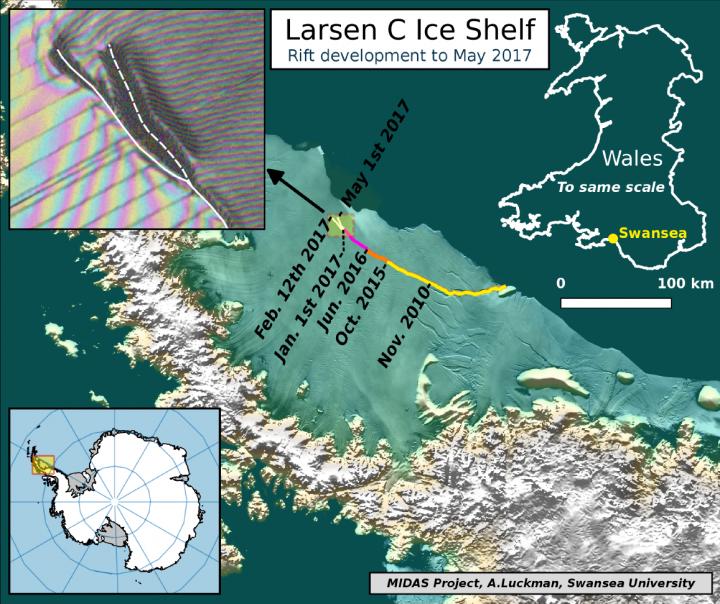
Credit: MIDAS project, A. Luckman, Swansea University
The rift in the Larsen C ice shelf in Antarctica now has a second branch, which is moving in the direction of the ice front, Swansea University researchers revealed after studying the latest satellite data.
The main rift in Larsen C, which is likely to lead to one of the largest icebergs ever recorded, is currently 180 km long. The new branch of the rift is 15 km long.
Last year, researchers from the UK's Project Midas, led by Swansea University, reported that the rift was growing fast. Now, just 20km of ice is keeping the 5,000 sq km piece from floating away.
Professor Adrian Luckman of Swansea University College of Science, head of Project Midas, described the latest findings:
"While the previous rift tip has not advanced, a new branch of the rift has been initiated. This is approximately 10km behind the previous tip, heading towards the ice-front.
This is the first significant change to the rift since February of this year. Although the rift length has been static for several months, it has been steadily widening, at rates in excess of a metre per day.
It is currently winter in Antarctica, therefore direct visual observations are rare and low resolution. Our observations of the rift are based on synthetic aperture radar (SAR) interferometry from ESA's Sentinel-1 satellites. Satellite radar interferometry allows a very precise monitoring of the rift development".
Researchers say the loss of a piece a quarter of the size of Wales will leave the whole shelf vulnerable to future break-up. Larsen C is approximately 350m thick and floats on the seas at the edge of West Antarctica, holding back the flow of glaciers that feed into it.
Professor Luckman said:
"When it calves, the Larsen C Ice Shelf will lose more than 10% of its area to leave the ice front at its most retreated position ever recorded; this event will fundamentally change the landscape of the Antarctic Peninsula.
We have previously shown that the new configuration will be less stable than it was prior to the rift, and that Larsen C may eventually follow the example of its neighbour Larsen B, which disintegrated in 2002 following a similar rift-induced calving event.
The MIDAS Project will continue to monitor the development of the rift and assess its ongoing impact on the ice shelf. Further updates will be available on our blog (projectmidas.org), and on our Twitter feed"
###
Visuals:
- The current location of the rift on Larsen C, as of May 1 2017. Labels highlight significant jumps. Tip positions are derived from Landsat (USGS) and Sentinel-1 InSAR (ESA) data. Background image blends BEDMAP2 Elevation (BAS) with MODIS MOA2009 Image mosaic (NSIDC). Other data from SCAR ADD and OSM. (Credit: MIDAS project, A. Luckman, Swansea University)
- Ice flow velocities of Larsen C in May 2017, from ESA Sentinel-1 data. (Credit: A. Luckman, MIDAS, Swansea University, with Copernicus Sentinel data.)
- Larsen C ice rift – aerial view. (Credit: John Sonntag/NASA)
Notes to editors:
Project MIDAS is a UK-based Antarctic research project, investigating the effects of a warming climate on the Larsen C ice shelf in West Antarctica. Recent warming has caused large melt ponds to form on Larsen C during summer, which are changing the structure of the ice. The effects of this on the future of the ice shelf are still unknown. We are studying these effects through a mixture of fieldwork, satellite observation and computer simulations of the ice shelf and its climate.
Project MIDAS is based at Swansea University and Aberystwyth University in Wales, with support from the British Antarctic Survey and a variety of partners both in the UK and internationally. The project is funded by the National Environment Research Council.
Swansea University is a world-class, research-led, dual campus university. The University was established in 1920 and was the first campus university in the UK. It currently offers around 350 undergraduate courses and 350 postgraduate courses to circa 20,000 undergraduate and postgraduate students.
The University's 46-acre Singleton Park Campus is located in beautiful parkland with views across Swansea Bay. The University's 65-acre science and innovation Bay Campus, which opened in September 2015, is located a few miles away on the eastern approach to the city. It has the distinction of having direct access to a beach and its own seafront promenade. Both campuses are close to the Gower Peninsula, the UK's first Area of Outstanding Natural Beauty.
Swansea is ranked the top university in Wales and is currently The Times and The Sunday Times 'Welsh University of the Year'. It is also ranked within the top 350 best universities in the world in the Times Higher Education World University rankings.
The results of the Research Excellence Framework (REF) 2014 showed the University has achieved its ambition to be a top 30 research University, soaring up the league table to 26th in the UK, with the 'biggest leap among research-intensive institutions' (Times Higher Education, December 2014) in the UK.
The University has ambitious expansion plans as it moves towards its centenary in 2020, as it continues to extend its global reach and realising its domestic and international ambitions.
Swansea University is a registered charity. No.1138342. Visit http://www.swansea.ac.uk
Contact details:
Kevin Sullivan, Public Relations Officer, Swansea University press office. [email protected] Tel 44 1792 513 245
Media Contact
Kevin Sullivan
[email protected]
@swanseauni
http://www.swansea.ac.uk/
############
Story Source: Materials provided by Scienmag





